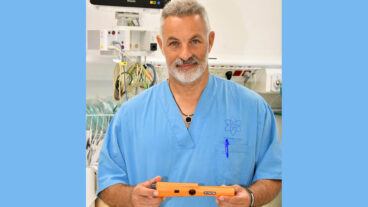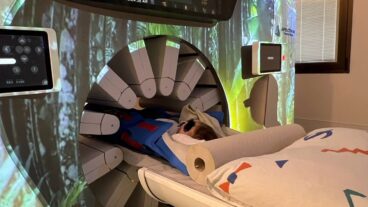Professor Stephen Gruber (left) and Professer Gad Rennert study the charts. (Photo: Gregory Fox/Medicine at Michigan)A joint US-Israeli research project has discovered that the drug L-thyroxin, most commonly used for the treatment of an underactive thyroid, can halve the risk of colorectal cancer (CRC). Scientists from the two countries announced at the current meeting of the American Association Cancer Research – Prevention Branch in Baltimore.
“The effect was pretty dramatic,” Professor Gad Rennert of the Rappaport Faculty of Medicine at the Technion Institute of Science, the head of the team, said at the conference. However, he added, “we have yet to understand the mechanisms. The literature on the subject is very minimal, but the finding is very strong. It is robust.”
The research was the continuation of a long-term collaboration between Rennert and Professor Stephen Gruber and the departments of Internal Medicine, Epidemiology and Human Genetics at the University of Michigan. The research partnership between Rennert and Gruber – which began in 1998 – has done much to provide the medical community with insights into the nature of CRC.
CRC, which affects large parts of the digestive system, is the second most common cause of cancer death in the US, with over 145,000 new cases reported each year and the cause of about 56,000 deaths expected in the US during 2005.
CRC, especially right-sided colon cancer, is known to be associated with a higher incidence of thyroid cancer. It is also known that an under active thyroid (hypothyroidism) impairs the function of the colon possibly leading to an increased risk of the development of CRC. Laboratory work has identified that there are important links between thyroid hormones and the processes that lead to the formation of cancerous colon cells.
The research project involved 2012 matched patient pairs; each pair consisting of a patient taking L-thyroxin for the treatment of hypothyroidism for five years or more, and matched for age, gender, and religion with a control subject not taking the drug.
There are many other factors known to be protective against colorectal cancer including sports activities and eating plenty of vegetables. However the US-Israeli research venture adjusted for all these known protective agents and still showed that the long-term use of L-thyroxin alone was associated with a 50% reduction in the risk of colorectal cancer.
The investigation, based on data from the Molecular Epidemiology of Colorectal Cancer (MECC) Study, clearly demonstrated the association between long-term L-thyroxin and a decreased risk in all types of colorectal cancer in all groups irrespective of age, religion or gender. However, the association reached statistical significance for Jewish females, people over the age of 65, and for European-American born patients.
What remains unclear is whether it is the dosing with L-thyroxin or the hypothyroidism itself which is producing this protective effect against CRC. There remains much work still be done. Rennert noted that “we don’t know where this is going to take us… I hope these findings will translate into future preventive measures.”
The study was published as an abstract and presented orally at the conference, though the data and conclusions should be considered to be preliminary as they have not yet been reviewed and published in a peer-reviewed publication.
Earlier this year, in another landmark epidemiological study in May, Rennert, Gruber and their colleagues showed that the cholesterol-lowering statin drugs almost halve the risk of developing CRC.
“Heart disease and cancer are the two big ailments of the Western world. It is incredible to think that we may be able to protect against both of them with the same extremely inexpensive drug,” said Rennert at the time.
Rennert, in addition to his Technion role, serves as the Director of the Clalit Health Services’ National Israeli Cancer Control Center and Chairman of the Department of Community Medicine and Epidemiology at the Carmel Medical Center.
Rennert and Gruber’s relationship began in 1998 when Dean Brenner, Professor of Internal Medicine and Pharmacology at the University of Michigan Medical School took his young colleague, Steve Gruber, with him to Israel to meet Professor ‘Gadi’ Rennert.
Gruber, a physician and cancer geneticist, had already decided that he wanted to study the genetic and lifestyle factors affecting the development of CRC. Israel was an ideal place to conduct such research because the incidence of CRC was known to be exceptionally high among Ashkenazi Jews (from Eastern Europe) and their descendants.
Rennert’s and Gruber’s interests and skills dovetailed perfectly; resulting, in 1999, in the foundation of the international MECC Study, with a $4.8 million grant from the US National Cancer Institute and additional funding from the Irving Weinstein Foundation.
Gruber’s lab specializes in DNA analysis, and Rennert’s team concentrates on selecting subjects for the studies with meticulous care. In 2002 they published a paper showing how the genetic profile of a subject increased their risk of the disease. Even people who had inherited a mutation from just one parent were shown to have a two to three times greater risk of CRC.
In an interview at the time Rennert explained his method for setting up matched pairs – “Let’s say I have an 82-year-old male cancer patient who is an Ashkenazi Jew living on a certain street in Haifa, we go to the same street and find an 82-year-old male Ashkenazi Jew who does not have cancer. This is not easy to do, but it’s the only way to ensure reliable data.”
This US-Israeli team went on to publish, at the beginning of 2004, some good news for people who had been identified at high risk from breast and ovarian cancer due to mutations in the BRCA1 and BRCA2 genes: there was no associated increase in risk for CRC.
While the US-lab has pursued detailed gene analysis, Gruber acknowledges that “we understand genes aren?t the whole story, because some people with genetic susceptibility develop the disease, while others do not. This is why Gadi’s field of research is so important. Without it we would have no way of understanding the role of diet and other environmental factors.”












